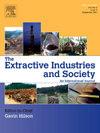Towards clean energy technologies: Assessing the supply potential of critical rare earth elements in China
IF 3.6
2区 社会学
Q2 ENVIRONMENTAL STUDIES
Extractive Industries and Society-An International Journal
Pub Date : 2024-12-19
DOI:10.1016/j.exis.2024.101603
引用次数: 0
Abstract
The rapid development of clean energy technologies will significantly increase the demand for rare earth elements (REEs). REEs such as dysprosium, terbium, praseodymium, and neodymium play an irreplaceable role in clean energy technologies like wind power equipment and electric vehicles. China is an important country for the supply of rare earths. Consequently, assessing China's supply potential and future trends of critical REEs is imperative. Considering the resource reserves, historical supply and the production characteristics of rare earth elements, we incorporated the parameter optimization algorithms into the multicyclic Generalized Weng model to obtain the production of critical REEs in China and quantify the supply potential. Our findings indicate that the supply potential of dysprosium peaks in 2030 at 15,900 tons (rare earth oxide equivalent), while terbium peaks in 2041 at 7,641 tons. Additionally, praseodymium will reach 7,606 tons in 2060 and neodymium will reach 33,560 tons in 2060, with peaks occurring after 2060. Compared with actual demand, it is found that there will be a supply shortage of dysprosium, neodymium, and praseodymium elements, and terbium will also face insufficient supply under high-demand scenarios. Based on these findings, policy recommendations are proposed to enhance REEs’ supply capabilities.
迈向清洁能源技术:评估中国关键稀土元素的供应潜力
清洁能源技术的快速发展将显著增加对稀土元素的需求。镝、铽、镨、钕等稀土元素在风力发电设备、电动汽车等清洁能源技术中发挥着不可替代的作用。中国是重要的稀土供应国。因此,评估中国关键稀土元素的供应潜力和未来趋势势在必行。考虑稀土资源储量、历史供给和稀土生产特征,将参数优化算法引入多环广义翁氏模型,得到中国临界稀土产量,并量化供应潜力。我们的研究结果表明,镝的供应潜力在2030年达到15,900吨(稀土氧化物当量)的峰值,而铽的供应潜力在2041年达到7,641吨的峰值。此外,2060年镨和钕将分别达到7606吨和33560吨,峰值出现在2060年之后。对比实际需求发现,镝、钕、镨元素将出现供应短缺,高需求情景下的铽也将面临供应不足。在此基础上,提出了提高稀土供应能力的政策建议。
本文章由计算机程序翻译,如有差异,请以英文原文为准。
求助全文
约1分钟内获得全文
求助全文
来源期刊

Extractive Industries and Society-An International Journal
ENVIRONMENTAL STUDIES-
CiteScore
6.60
自引率
19.40%
发文量
135
 求助内容:
求助内容: 应助结果提醒方式:
应助结果提醒方式:


